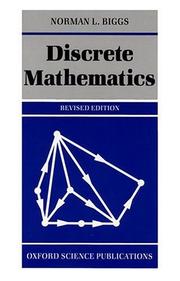Check nearby libraries
Buy this book

This work doesn't have a description yet. Can you add one?
Check nearby libraries
Buy this book

Previews available in: English
| Edition | Availability |
|---|---|
| 1 |
zzzz
|
|
2
Discrete Mathematics (Oxford Science Publications)
September 2, 1993, Oxford University Press, USA
in English
0198534272 9780198534273
|
aaaa
|
|
3
Discrete mathematics
1989, Clarendon Press, Oxford University Press
in English
- Rev. ed.
0198534264 9780198534266
|
zzzz
|
| 4 |
zzzz
|
|
5
Discrete mathematics
1985, Clarendon Press, Oxford University Press
in English
0198532520 9780198532521
|
zzzz
|
Book Details
Table of Contents
Edition Identifiers
Work Identifiers
Community Reviews (0)
| August 17, 2024 | Edited by MARC Bot | import existing book |
| December 19, 2023 | Edited by ImportBot | import existing book |
| December 19, 2023 | Edited by ImportBot | import existing book |
| August 28, 2020 | Edited by Drini | Edited without comment. |
| December 10, 2009 | Created by WorkBot | add works page |















